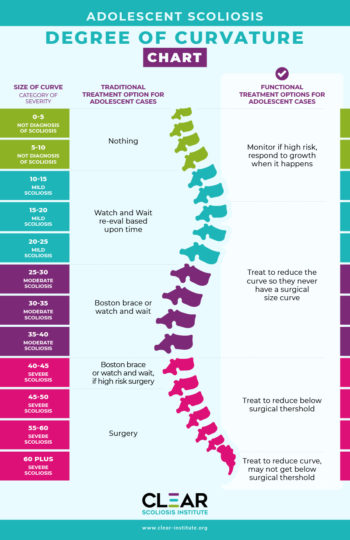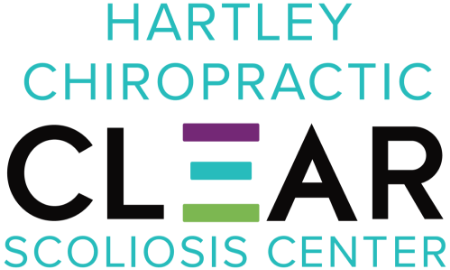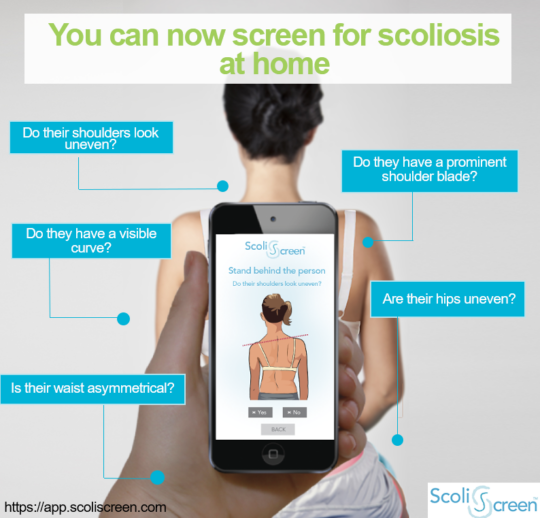September 7, 2022 Newsletter
For an adolescent on the traditional path of scoliosis treatment, nothing is done while scoliosis is at the mild
severity level of between 10 and 25 degrees.
As scoliosis is a structural spinal condition, first and foremost, effective treatment has to impact it on a structural
level.
Adolescent Scoliosis Degrees of Curvature Chart
Author: Dr. J Hartley
No two cases of scoliosis are the same, which is why there is no clear-cut answer regarding its treatment needs;
the very nature of scoliosis necessitates the customization of effective treatment plans. There are also different
scoliosis treatment approaches that offer patients different potential results, and different severity levels.
Scoliosis is a complex condition. Not only are there different condition types, but also different severity
levels ranging from mild to severe. The accompanying adolescent scoliosis degrees of curvature chart
shows how the two main scoliosis treatment approaches respond at each severity level.
Follow along the accompanying adolescent scoliosis degrees chart so we can explore what each severity level of
scoliosis involves in terms of treatment, but first, lets talk generally about the two main scoliosis treatment
approaches.
Scoliosis Treatment Approaches: Traditional and Functional
Once a scoliosis diagnosis is given, the most important decision is how to treat it moving forward.
There are two main scoliosis treatment approaches that respond differently to the condition at each severity
level: traditional and functional.
Its important for patients, and their families, to understand the differences between the two main scoliosis
treatment approaches because each offers different potential results that can have far-reaching effects.
While scoliosis is highly treatable, it is not curable, so how its managed throughout treatment and beyond can
shape a persons experience of life with the condition.
Scoliosis can affect all ages, but its most-prevalent form is adolescent idiopathic scoliosis (AIS), diagnosed
between the ages of 10 and 18: the condition type were focusing on for our current purposes.
While the traditional treatment approach for scoliosis has been in place for many years, it has changed little over
those years, despite our growing understanding of the condition and how it responds to treatment.
Traditional treatment is often described as reactive, while a modern functional approach, also known as
conservative and/or chiropractic-centered is more proactive, which is evident in the different ways each treatment
approach responds to the different severity levels.
A patients severity level is determined by a measurement obtained during X-ray: Cobb angle.
A patients Cobb angle is determined by drawing lines from the tops and bottoms of the curvatures most-tilted
vertebrae, at the apex of the curve; the intersecting angle is measured in degrees and places conditions on a
severity scale of mild to severe:
Mild scoliosis: Cobb angle measurement of between 10 and 25 degrees
Moderate scoliosis: Cobb angle measurement of between 25 and 40 degrees
Severe scoliosis: Cobb angle measurement of 40+ degrees
Now that weve talked generally about the two main scoliosis treatment approaches and how adolescent
idiopathic scoliosis is classified in terms of severity, lets talk about how a scoliosis diagnosis is met, and then
move on to what happens at each severity level, in terms of treatment.
Being Diagnosed with Scoliosis
In order to reach a scoliosis diagnosis, certain parameters have to be met; a person has to have an unnatural
sideways spinal curve, with rotation, and a minimum Cobb angle of 10 degrees.
For both traditional and functional treatment approaches, if the above parameters are met, a diagnosis of
scoliosis can be given.
Part of the diagnostic process involves further assessing and classifying conditions based on a number of
important variables: patient age, causation (if known), curvature location, and condition severity.
So if adolescent idiopathic scoliosis is diagnosed with a Cobb angle measurement of between 10 and 25
degrees, how does each treatment approach respond?
Mild Adolescent Idiopathic Scoliosis and Traditional Treatment
For an adolescent on the traditional path of scoliosis treatment, nothing is done while scoliosis is at the mild
severity level of between 10 and 25 degrees.
Patients with mild scoliosis are advised to solely watch and wait for signs of further progression, and depending
on patient age and the treatment-provider, are commonly told to return for assessment at periodic intervals every
3, 6, to 12 months.
Mild Adolescent Idiopathic Scoliosis and Functional Treatment
For adolescent patients on the functional path of scoliosis treatment, mild scoliosis is responded to proactively by
applying treatment as close to the time of diagnosis as possible.
Because scoliosis is progressive, we know virtually every case is going to worsen at some point, so watching and
waiting while a scoliotic curve progresses unimpeded is wasting valuable treatment time.
As growth and development is the conditions main trigger for progression, adolescents are at risk for rapid-phase
progression due to the stage of puberty and its rapid and unpredictable growth spurts.
If a patient has a significant growth spurt in between scheduled assessments, this can cause the condition to
progress quickly, which might have been avoidable had proactive treatment been applied earlier on.
In addition, while there are no treatment guarantees, early detection and proactive treatment applied while a
condition is mild increases chances of treatment success; the treatment process is simpler while a condition is
mild, the curve is smaller, more flexible, and before the body has had time to adjust to the unnatural spinal curves
presence.
Under a functional approach, treatment of mild scoliosis involves combining therapy, rehab, scoliosis-specific
exercises, and chiropractic care, while continuously monitoring for progression and adjusting treatment plans
based on how the spine is responding.
If a condition progresses to the next severity level, were talking about moderate scoliosis, which tends to be
when symptoms become more noticeable.
Moderate Adolescent Idiopathic Scoliosis and Traditional Treatment
Cobb angle measurements of between 25 and 40 degrees are classified as moderate scoliosis, and for patients
receiving traditional treatment, the only form of treatment applied is traditional bracing.
Bracing for scoliosis can be an effective facet of treatment, but only when combined with other forms of treatment
so the condition is impacted on multiple levels.
The most common type of traditional scoliosis brace used is the Boston brace, which is associated with a number
of shortfalls:
Addresses the condition as 2-dimensional
Works by squeezing the spine from the sides, which can weaken the spine
Can increase postural deviation
The Boston is mass-produced and cumbersome, leading to compliance issues
The Boston has the end goal of stopping progression, not correction
Fortunately, just as there are different approaches to scoliosis treatment that offer patients different potential
results, there are also multiple bracing options.
Moderate Adolescent Idiopathic Scoliosis and Functional Treatment
For adolescents receiving functional treatment for their scoliosis, we are talking about combining multiple
treatment modalities to impact scoliosis on every level.
As a CLEAR-certified scoliosis chiropractor, I see a lot of patients with moderate scoliosis because, as
mentioned, this is when symptoms, like postural changes, tend to become noticeable, leading to a diagnosis and
treatment.
Common postural symptoms of AIS include uneven shoulders, hips, and the development of a rib arch.
As scoliosis is a structural spinal condition, first and foremost, effective treatment has to impact it on a structural
level.
With condition-specific chiropractic care, I can apply chiropractic adjustments to the curves most-tilted vertebrae
and work towards repositioning them back into alignment with the rest of the spine: restoring as much of the
spines natural curves as possible.
Through applying a variety of therapies and custom-prescribed scoliosis-specific exercises, I can help patients
increase their core strength so the spine is optimally supported and stabilized by its surrounding muscles.
In addition, SSEs can activate certain areas of the brain for enhanced brain-body communication, postural
remodeling, and improved body positioning.
At the moderate level, I want to proactively treat conditions to prevent progressing into the severe classification
level to avoid escalating symptoms and the need for more invasive treatment in the future: spinal fusion surgery.
If a patients Cobb angle increases into the 40+ range, this is the severe classification and is approaching the
surgical-level threshold.
Severe Adolescent Idiopathic Scoliosis and Traditional Treatment
At the 40+ curvature-degree level, were talking about severe scoliosis, and for those undergoing traditional
treatment, monitoring continues, bracing is likely to continue, and if unsuccessful at stopping further progression,
the surgical-level threshold is crossed.
In many cases, this is when patients are funneled towards spinal fusion surgery.
While all surgeries come with their share of risks, spinal fusion is a complex, lengthy, and invasive procedure that
carries some heavy potential risks and side effects:
Risk of infection
Excessive blood loss
Hardware failure
Adverse reaction to hardware used
Nerve damage
Increased pain at the fusion site
Loss of spinal flexibility = reduced range of motion
Increased risk of spinal injury
Psychological impact of living with a fused spine
While spinal fusion has its place in scoliosis treatment, the reality is that many cases can be treated
nonsurgically.
Severe Adolescent Idiopathic Scoliosis and Functional Treatment
If a patient comes to me with severe scoliosis and is wanting to forego a surgical recommendation in favor of
trying a safer, more natural, less-invasive treatment option first, the focus is on stabilizing the spine and reducing
the curve by integrating chiropractic adjustments, homes exercises, rehab, and corrective bracing.
To meet my patients bracing needs, I opt for the modern ultra-corrective ScoliBrace because it represents the
culmination of what weve learned about the condition over the years, and how it responds to treatment.
The ScoliBrace addresses many of the shortcomings associated with the traditional Boston brace:
Addresses the conditions true 3-dimensional nature (rotational component)
Pushes the spine into a corrective position, rather than squeezing it unnaturally
Improves postural deviation
Uses state-of-the-art scanning technology to customize braces to suit body/curvature type
Has the end goal of correction on a structural level
When combined with other forms of scoliosis-specific treatment disciplines, the ScoliBrace can augment
corrective results by helping to stabilize and support the spine, while holding it in a corrective position.
At this level, we work towards reducing a curve below the surgical-threshold level to avoid the need for spinal
fusion.
Conclusion
Part of the reason scoliosis is so often deemed a complex condition is in addition to its multiple condition types,
there are also different severity levels.
The accompanying scoliosis degrees chart shows how highly variable the condition can be, ranging from mild to
moderate and severe.
As a CLEAR-certified scoliosis chiropractor, I follow the CLEAR Scoliosis Institutes treatment protocols which
involves a proactive and functional treatment approach with the end goal of correction on a structural level, while
preserving as much of the spines natural function as possible.
The traditional scoliosis treatment approach is more reactive than proactive and tends to funnel patients towards
spinal fusion surgery, which has its share of potential risks and side effects.
The important thing for patients, and their families, to understand is that different scoliosis treatment approaches
offer different potential outcomes, and awareness of the differences can set patients on the right path in terms of
treatment outcome.
Dont forget to sign up for our new Spinal Health and Wellness class at the front desk, email
hatleychiro@gmail.com, or call 904-679-3233.
Hartley Chiropractic and CLEAR Scoliosis Center
1740 Tree Blvd. #115
St Augustine, FL 32084


